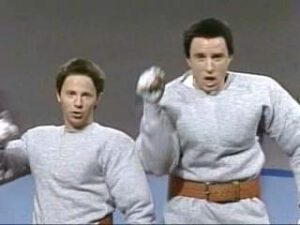Strength Exercises: Don’t Sweat the Technique?
Today’s guest blog comes from current CP Intern Conor Nordengren.
During one of my recent morning drives to Cressey Performance, I was listening to the radio when I heard one of my favorite songs from my youth: “Don’t Sweat the Technique” by Eric B. and Rakim.
As I was fist-pumping (a la Tony Gentilcore), I realized that I had never actually paid attention to the lyrics of the song. Mid fist-pump, I put my hand down so I could listen closely to the words. After hearing the chorus, I was shocked: “Don’t sweat the technique?” Really? In my sudden state of anger and disbelief, I came to another realization: this must be why Eric hates rap!
Ever since that morning commute, the word “technique” has been stuck in my mind. More specifically, how it pertains to strength and conditioning and just lifting weights in general.
One of the first things I learned when I began my internship at CP was the importance of proper technique. This often neglected aspect of training is constantly stressed here. Eric, Tony, and Chris are always out on the floor coaching, cueing, and correcting technique. When us interns aren’t scheduling Eric’s next seaweed body wrap at the spa or picking up Tony a tall, iced peppermint white chocolate mocha espresso (with extra sprinkles) from Starbucks, all of our time is spent out on the floor actively coaching as well.
The great thing about CP is that everyone who trains here is aware of the importance of proper technique, too. Many times, I’ll be out on the floor and a client will come up to me and ask me to watch their form on a certain strength exercise. I’ve had this happen with athletes who are in middle school, to pro baseball guys who are veterans of CP, and also with those so-called “weekend warriors.” I have to admit, I love it when this happens! This means that the client is not only cognizant of the importance of technique, but is looking to improve upon or maintain their technique; it also tells me that they truly care about their training and their goals.
The other week, a younger CP athlete was doing a set of pull-throughs with less than stellar technique. As Chris quickly came to the rescue, I listened in to what he was saying and I came away with one of those “Ah-ha!” moments along with a great quote to remember. Chris said, “Right now, we really need to focus on technique; we have plenty of time to get you strong.” A lot of young kids or beginners who are fairly new to lifting weights will sometimes have the tendency to want to use too much weight on their exercises. While they are still learning and improving upon their form, putting too much weight on the bar can prove to be injurious. This can be a problem for even the more experienced lifter if they are losing focus on their technique. Whether you are picking up a weight for the first time or you’ve been lifting for many years, you need to constantly be aware of your form. When you enter the weight room, leave your ego at the door because technique is far more important than the amount of weight you can lift. The cool thing is, as your form becomes very good, your chances of progressing faster and lifting more weight become greater. And don’t worry, no informed lifter is going to think you’re a “girly man” if you take some weight off the bar to work on your technique.
Competitive powerlifter Chad Aichs wrote an article last month about constantly “hammering” technique. Now, Chad has been lifting for a long time and is one of the strongest guys in the world (2733 total in the squat, bench, and deadlift). Suffice it to say, when Chad’s talking, I’m listening. According to him, technique must be the foundation of everyone’s training program. When you begin your workout, from your warm-up to post-workout stretching, you should strive to perform every movement with picture-perfect form. During our staff lifts at CP, we’re always watching each other’s lifts and giving each other feedback when necessary. While this usually consists of Eric yelling at Pete from across the gym telling him that his form is about as good as a brain-dead, overweight, arthritic donkey, that’s beside the point.
The lesson here is that I’m lifting with some of the most knowledgeable, experienced coaches out there and they’re still critiquing each other’s form. In other words, you are never too experienced to not monitor and improve your technique. Holding yourself to high standards when it comes to technique keeps it in check and allows you to put your body in its strongest, safest position to lift the most weight and stay injury-free. If you train alone and don’t have an experienced eye to watch your form, try to video yourself performing a certain lift. This way, you can self-correct your technique and/or post it online to have others chime in on what you may need to improve upon. I know that may sound a little extreme to some of you, but if you’re serious about your training, it may be necessary for you to get better and make progress toward your goals.
While striving for perfect form is great and very important, I agree with Bret Contreras’ application of the 80/20 Principle when it comes to technique. Basically, your form should never break down more than 20%. This 20% serves as a bit of a leeway that is necessary for lifters to make progress and get stronger. On a scale of 0 to 10, 0 being horrendous and 10 being perfect, at the very least you want to score an 8. However, an 8 should only be allowed on heavier sets that are more challenging. All other sets, including warm-ups and the initial working sets, should be 10’s. I’ve seen Bret’s theory in play in my own training. During a recent trap bar deadlift session, I set out to perform 5 sets of 5. I was feeling good that day, so I decided to increase the weight for my last working set. My first 3 reps were 10’s, but during my last 2 reps, I lost a bit of the tightness in my back, and would’ve characterized them as an 8 or a 9. Even though my form was not completely perfect, it was not a significant break down that would put me at a great risk of injury. Always be aware of your technique, but don’t obsess about it to the point where you’re limiting your progress. On the other hand, don’t be too careless where you’re putting yourself at a heightened risk for injury; a.k.a. don’t be this guy (and I’m not just talking about his hair):
Improving your form and keeping certain cues in mind is not an easy thing. There are several things to remember regarding technique while executing a given lift, and at times, it can seem overwhelming, especially if you lift alone. If this is how you feel, try this little trick that Tony uses with his clients. Say you’re performing a deadlift, whether you’re somebody who’s just learning this movement or a veteran lifter who’s doing a heavy set. Instead of just motoring through each rep of your set, treat each rep as its own set. You can think of it as sort of “resetting” yourself after each repetition. Before your first rep, get yourself into position and go through a mental checklist of key cues. Perform the rep, set the weight down (or just a pause for other movements), and quickly go through that mental checklist again to make sure you’re ready to perform the next rep with proper technique. This is a simple yet effective tool for keeping form tight that can be applied to almost any exercise.
So I guess what I’m trying to say is that Eric B. and Rakim are full of crap; you better “SWEAT the technique!” Proper resistance training technique will allow you to progress faster, get stronger, stay injury-free, and ultimately help you to reach your goals. As Chad Aichs has said, “Technique is everything.”
Conor Nordengren can be reached at cnordengren@gmail.com.
Sign-up Today for our FREE Newsletter and Receive a Deadlift Technique Video!







